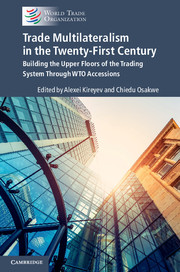 Trade Multilateralism in the Twenty-First Century
Trade Multilateralism in the Twenty-First Century Book contents
- Frontmatter
- Contents
- List of Plates
- List of Figures
- Notes on Contributors
- Foreword
- Acknowledgements
- List of Abbreviations
- Disclaimer
- 1 Making Trade Multilateralism Work for All: The Role of WTO Accessions
- PART I WTO Accessions and the New Trade Multilateralism
- PART II Negotiators’ Perspectives on the WTO Accession Process
- PART III Accessions Acquis: Thematic Perspectives and Implementation Challenges
- 13 How Post-TRIPS Negotiations Reframe the ‘Trade-Related Aspects’ of Intellectual Property after TRIPS: The Lessons of WTO Accessions
- 14 Competition Policy in WTO Accessions: Filling in the Blanks in the International Trading System
- 15 Geographical Indications in the Accessions Landscape
- 16 WTO Accession Commitments on Agriculture: Lessons for WTO Rule-Making
- 17 The WTO-Plus Obligations: Dual Class or a Strengthened System?
- 18 Accession Protocols and the Private Sector
- 19 Post-Accession Support Platform
- 20 Conclusion: Trade Multilateralism - Enhancing Flexibility, Preserving the Momentum
- Contributor Biographies
- Index
20 - Conclusion: Trade Multilateralism - Enhancing Flexibility, Preserving the Momentum
from PART III - Accessions Acquis: Thematic Perspectives and Implementation Challenges
Published online by Cambridge University Press: 28 November 2017
- Frontmatter
- Contents
- List of Plates
- List of Figures
- Notes on Contributors
- Foreword
- Acknowledgements
- List of Abbreviations
- Disclaimer
- 1 Making Trade Multilateralism Work for All: The Role of WTO Accessions
- PART I WTO Accessions and the New Trade Multilateralism
- PART II Negotiators’ Perspectives on the WTO Accession Process
- PART III Accessions Acquis: Thematic Perspectives and Implementation Challenges
- 13 How Post-TRIPS Negotiations Reframe the ‘Trade-Related Aspects’ of Intellectual Property after TRIPS: The Lessons of WTO Accessions
- 14 Competition Policy in WTO Accessions: Filling in the Blanks in the International Trading System
- 15 Geographical Indications in the Accessions Landscape
- 16 WTO Accession Commitments on Agriculture: Lessons for WTO Rule-Making
- 17 The WTO-Plus Obligations: Dual Class or a Strengthened System?
- 18 Accession Protocols and the Private Sector
- 19 Post-Accession Support Platform
- 20 Conclusion: Trade Multilateralism - Enhancing Flexibility, Preserving the Momentum
- Contributor Biographies
- Index
Summary
The book you are about to close picked up on the evolving discussion on accessions and trade multilateralism. The first book on the subject, WTO Accessions and Trade Multilateralism: Case Studies and Lessons from the WTO at Twenty, looked back. It took stock of two decades of accessions to the WTO, their welfare and development outcomes, the resulting improvements to market access, and their contribution to domestic reforms and to the rules-based multilateral trading system. It shone a powerful light on the GATT/WTO accession procedure – a process hitherto viewed as lacking transparency and complicated by its esoteric vocabulary and apparent detachment from the day-to-day conduct of trade.
This book looks forward. It focuses on the future of the multilateral trading system and the role of accessions in shaping it. It highlights the challenges of maintaining the system in a global economic and trade policy environment marked by radical transformation and uncertainty accentuated by fast-paced technological changes.
Clearly, the multilateral trading system needs to transform and adapt to this continually evolving environment. While it must remain a ballast for stability and global order, for policy relevance it must also adjust to the complex realities of a different age, an age in which one size cannot possibly fit all. The architecture of the rules-based system requires flexibility to adapt to the different needs of its members in different configurations, ranging from those focused on domestic policy reforms to those motivated by bilateral, plurilateral or regional trade integration priorities. A self-learning and adaptive multilateralism can accommodate these opposite pulls and pressures in a rules-based order. But multilateralism is only one piece of the puzzle and its abundant benefits are accompanied by a price. The price of multilateralism is constant adaptation, operation in different formats and in step with a complex reality. As argued elsewhere, there is a case for a ‘messy’ multilateralism, because ‘multilateralism is not one thing, but many’ (Haass, 2010).
The new realities of the twenty-first century require an upgrade of the multilateral trading system by erecting its upper floors on the foundation of the existing trade rules and the accumulated acquis.
- Type
- Chapter
- Information
- Trade Multilateralism in the Twenty-First CenturyBuilding the Upper Floors of the Trading System through WTO Accessions, pp. 405 - 408Publisher: Cambridge University PressPrint publication year: 2017
